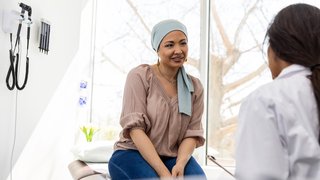
Decoding the Body’s Biomarkers
From profiling genes to targeting molecules, research discoveries are bringing important benefits to patients.
1. Fighting Cancer with Immunotherapy Biomarkers
With immunotherapy, a patient’s own immune system is recruited to battle cancer. “In a subset of cancers, the patient’s immune system is able to recognize the cancer cells as foreign and starts to generate an antitumor immune response,” explains Sangeetha Reddy, M.D., a breast medical oncologist at Simmons Cancer Center. If the cancer fights back, immunotherapy can help the patient’s immune cells kill the cancer cells.
But immunotherapy doesn’t work in all patients, and it can have side effects. “The immune system can be activated against not only the tumor but also against the patient’s normal body cells, leading to autoimmune toxicities,” Dr. Reddy says. Identifying biomarkers helps doctors identify the patients most likely to benefit from immunotherapy and least likely to suffer dangerous side effects from the treatment.
“Studying our patients’ cancer tissue and blood samples will also help us identify better treatment strategies as we strive to increase the numbers of patients who will respond to these types of therapies,” Dr. Reddy says.
She adds: “An important part of providing personalized cancer care for each patient is studying each patient’s tumor to understand what is uniquely driving each person’s cancer and then identifying the best treatment options, whether that is a certain immunotherapy, a targeted therapy, or chemotherapy, or some combination.” Dr. Reddy and others at UT Southwestern have developed tissue-collection protocols as well as a clinical trial program to push this type of personalized medicine forward.
“Studying our patients’ cancer tissue and blood samples will also help us identify better treatment strategies as we strive to increase the numbers of patients who will respond to these types of therapies.”
Sangeetha Reddy, M.D.
2. Personalizing Therapy with Novel Approaches
Despite advances in this area, some cancers, such as kidney cancer, have proved more challenging than others, and reliable biomarkers remain elusive. However, new research from the Kidney Cancer Program at UT Southwestern shows a promising path forward.
Investigators have developed a means for identifying patients most likely to respond to immunotherapy. The novel radiology test is designed to illuminate kidney cancers that respond to checkpoint inhibitors, the most common form of immunotherapy treatment today.
The strategy involves transforming an immunotherapy drug into a diagnostic tracer that can be visualized using a PET (positron emission tomography) scanner, which is routinely used for diagnostics. Most commonly, PET scanners are used to visualize a sugar tracer (radioactive-labeled glucose), which is readily taken up by cancer cells, allowing their discovery by PET. In the current research, investigators have taken an immunotherapy drug and labeled it with a radioactive particle generated at UT Southwestern’s cyclotron facility. Employing a single, small dose of the drug (1% of the treatment dose), the investigators can see whether the tumor is likely to be recognized by the drug and determine whether the patient will respond to immunotherapy.
Referred to as iPET (for immuno-PET), this new approach opens a molecular window to what is going on inside a cancer patient. After obtaining an investigational new drug approval from the U.S. Food and Drug Administration, investigators have opened a clinical trial, led by Alex Bowman, M.D., an Assistant Professor in the Division of Hematology/Oncology at UT Southwestern.
Existing checkpoint inhibitors work on kidney cancer but only in about 40% of patients. “We hope that by using this approach we can figure out who is in that 40% and spare the patients who are unlikely to benefit,” says James Brugarolas, M.D., Ph.D., Director of the Kidney Cancer Program.
Another new initiative builds on UT Southwestern’s discoveries pertaining to the genetics of kidney cancer. Investigators with the Kidney Cancer Program uncovered a specific gene that is mutated in some patients, leading to more aggressive disease, a worse prognosis, and a life expectancy diminished by approximately half. Investigators are using a variety of approaches, including artificial intelligence and machine learning, to better understand how the mutation induces aggressive kidney cancer and to identify targets for drug development.
3. Fighting Wasting Syndrome
Cachexia is a very serious and prevalent problem for people with cancer. It’s a wasting syndrome that affects about 50% of people with cancerous solid tumors, and it’s responsible for about 30% of cancer-related deaths. Patients with cachexia often have loss of fat, muscle, and appetite without knowing why.
“If we can reverse cachexia, patients live longer, regardless of treatments specifically targeting their tumors,” says Puneeth Iyengar, M.D., Ph.D., a radiation oncologist at UT Southwestern. “My collaborator, Rodney Infante, M.D., Ph.D., and I are attempting to identify a set of biomarkers that would allow us to predict whether a patient is going to lose additional weight as part of cachexia syndrome. If we can identify patients early in cachexia, then pharmacological interventions might be valuable in reversing the effects of the syndrome.”
Drs. Infante and Iyengar are tackling this problem on two fronts: They are seeking to understand how cachexia develops in animal models and cell culture-based systems, and they are trying to identify those patients who are at higher risk for developing cachexia at some stage in their disease course.
For their research, they are collecting blood and tissue samples from newly diagnosed cancer patients, and they plan to continue collecting samples from those patients.
“Ideally, we will collect samples from patients who never develop cachexia, samples from patients with mild versions, and then some with very significant versions,” Dr. Iyengar says. They can then examine those samples to identify biomarkers of cachexia that correlate with the clinical manifestations of the syndrome.
Learn more about the research underway at UT Southwestern.










